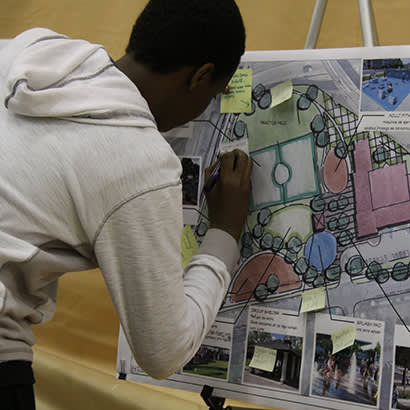
For an enhanced digital experience, read this story in the ezine.
As communities across the country look at righting existing inequities in park investments and improvements, they face common challenges. Some of the toughest questions to address are how to fairly prioritize investments and how to ensure the park’s design or redesign ultimately advances equity.
For decades, Confluence has been working with park departments to address issues of equity in park planning and design. While each park and community are different, there is a general framework that can facilitate the creation of a more equitable parks system.
Leveling the Playing Field
Equitably allocating budgets means understanding the level of park service currently available throughout the entire community and directing dollars in a prioritized fashion to address areas of need. The first challenge is to create a fair system through which parks are assessed and evaluated.
Through our work with the Minneapolis Park and Recreation Board, we were introduced to a robust 23-point system, which scores parks using community demographics and park characteristics. These scores help inform prioritization of investment. While theirs is one of the largest parks systems in the nation, this evaluation system offers a powerful model for supporting greater equity in park investments in other communities.
Confluence has since adapted this model for use in other communities, including Bloomington, Minnesota, where we worked with the city on the Bloomington Park System Master Plan, framing how Bloomington Parks and Recreation could be successful in understanding and advancing racial and economic equity among its more than 90 highly-diverse parks. Tailoring the tools and information being analyzed and customizing the evaluation methodology allow us to achieve each community’s specific equity goals and metrics.
Rethinking Engagement
Once a park has been identified for investment, the next step is ensuring an equitable community engagement process. Successful engagement is about who you are seeking input from, where you are doing the outreach and who is doing the asking.
There is an inherent connection between a designer’s or planner’s background, experiences and biases, and their produced work. Black professionals, Indigenous professionals and other professionals from various racial and ethnic backgrounds are still vastly underrepresented in the landscape architecture, planning and design field, which can create challenges for connecting and building trust with diverse communities.
To ensure a project’s design is reflective of the needs and wants of the community it will serve, planning and design firms also should partner with local organizations that are already deeply immersed in the local community.
Meeting groups of different socioeconomic and cultural backgrounds where and how they are most comfortable is vital to this process. We have found a combination of both in-person, facilitated interactions at a variety of times to allow for different work and childcare schedules, alongside online engagement methodologies, is important for securing the broadest input.
Open lines of dialogue with communities — particularly those that have historically been left out of conversations — often result in significant changes to a park’s design. For example, in the South Service Area of Minneapolis, the design shifted away from clustered sports diamonds in favor of multiuse fields, recognizing changing demographics within certain neighborhoods had led to stronger needs for soccer and football facilities over the systems’ ubiquitous softball fields.
Keep Up the Good Work
Cities must continue building and strengthening relationships with underrepresented populations while listening and responding to identified needs throughout the planning, design and implementation process. By incorporating ongoing dialogue and engagement as a key part of the process, cities and parks systems can ensure the creation of spaces that serve everyone’s needs.
Terry Minarik, PLA, ASLA, is Principal/Shareholder at Confluence. Brad Aldrich, PLA, LEED AP BD+C, ASLA, is Associate Principal at Confluence.

